As an Amazon Associate CoffeeXplore.com earns from qualifying purchases.
Genius Mini Cafe Design Interiors To Maximize A Small Space
Feeling trapped by four small walls? When you dream of opening a vibrant, bustling cafe, the reality of a tiny footprint can feel more like a constraint than a canvas. The challenge of fitting a functional counter, comfortable seating, and a memorable atmosphere into limited square footage, all while sticking to a tight budget, can seem overwhelming. It’s easy to believe that a small space means sacrificing style, function, and the customer experience you’ve envisioned.
But what if that small space wasn’t a limitation, but your greatest advantage? What if its constraints were the very things that forced you to be more creative, more intentional, and ultimately, more memorable? A mini cafe has the unique potential to be a cozy, intimate haven that larger, cavernous spaces can only dream of. It’s about being clever, strategic, and seeing the potential in every square inch.
Designing a mini cafe involves strategic planning around a central theme, using multi-functional furniture, and leveraging smart lighting and color schemes. The goal is to create an illusion of space while ensuring a cohesive, inviting atmosphere that maximizes every square foot efficiently and affordably. Drawing on principles from successful small-footprint cafes worldwide, we’ve distilled the most effective strategies that blend aesthetics with practicality.
Feeling Cramped? How to Turn Your Tiny Cafe into a Customer Magnet
The key to designing a successful mini cafe is to view its small size as an opportunity for creativity and intimacy. Instead of focusing on the lack of space, concentrate on maximizing every vertical and horizontal inch with smart, multi-functional solutions. By embracing clever design concepts, you can create a functional, stylish, and inviting atmosphere that feels spacious and leaves a lasting impression on your customers, even on a low budget. The secret lies in blending functional layouts with an aesthetic that tells your brand’s story, turning potential challenges into charming features that make your cafe a go-to destination.
7 Genius Mini Cafe Design Interiors to Maximize A Small Space (Updated for 2025)
Ready to transform your small space into a stunning and efficient cafe? These seven genius design concepts are your blueprint for success. Each idea is packed with actionable steps, pro tips, and visual inspiration to help you create a memorable experience that customers will love. These curated concepts are based on proven interior design principles for small commercial spaces and are adaptable to various budgets and brand aesthetics. Let’s dive in and unlock the full potential of your mini cafe.
1. The Art of Verticality: Drawing the Eye Upward
When floor space is limited, the only way to go is up, and using floor-to-ceiling shelving is the most effective way to add storage and create the illusion of height. This strategy draws the customer’s eye upward, making the entire room feel taller and more open. Open shelving, in particular, prevents the “boxed-in” feeling that solid cabinetry can create, allowing you to display products, decor, and essentials in an artful, organized way.
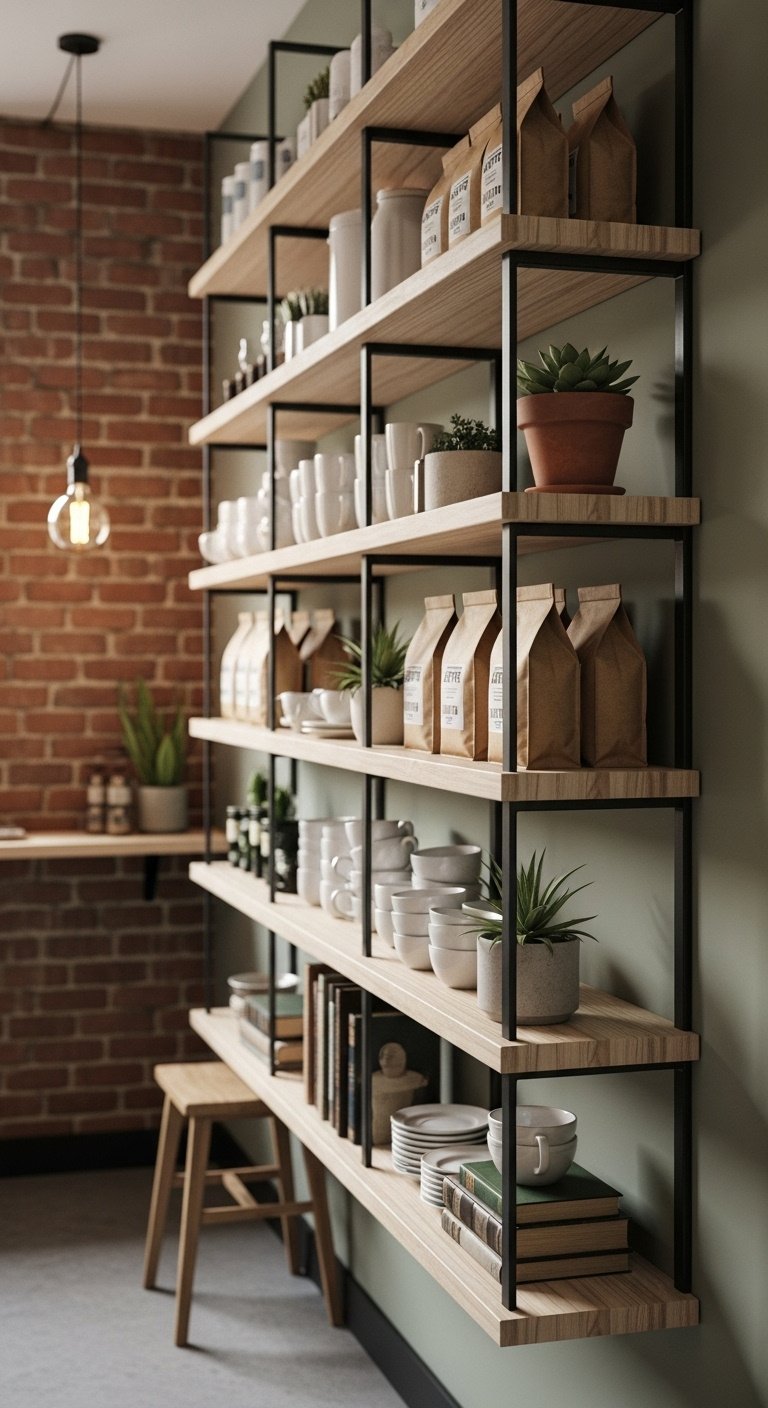
Pin this clever vertical storage solution to your ‘Cafe Design’ board!
Materials Needed: Wall stud finder, level, drill, wall anchors, screws, shelving brackets (e.g., metal pipe, minimalist black), wood planks (reclaimed or new).
Step-by-Step Directions:
- Plan Your Layout: Measure your wall space and decide on the height and spacing of your shelves.
- Locate Studs: Use a stud finder to mark the location of wall studs for secure mounting. This is crucial for holding weight.
- Install Brackets: Use your level to ensure the brackets are perfectly straight. Drill pilot holes and secure the brackets to the studs using screws. If no stud is available, use heavy-duty wall anchors.
- Attach Shelves: Place your wood planks onto the brackets and secure them from underneath with small screws.
- Style Your Display: Arrange your merchandise, plants, and decor items. Keep it uncluttered to maintain an open feel.
Pro-Tip: Use the highest shelves for decorative items that don’t require frequent access, and keep everyday supplies on the lower, easily reachable shelves.
2. The Chameleon Corner: Multi-Functional & Movable Furniture
In a mini cafe, every piece of furniture must earn its place, which means choosing adaptable pieces like foldable tables and stackable stools is essential for a flexible layout. This approach allows your cafe to transform based on the time of day or need. A quiet morning spot for solo laptop workers can become a more open space for an afternoon rush or a small evening event. Movable, multi-functional furniture gives you control over your space, ensuring it’s always working its hardest for you.
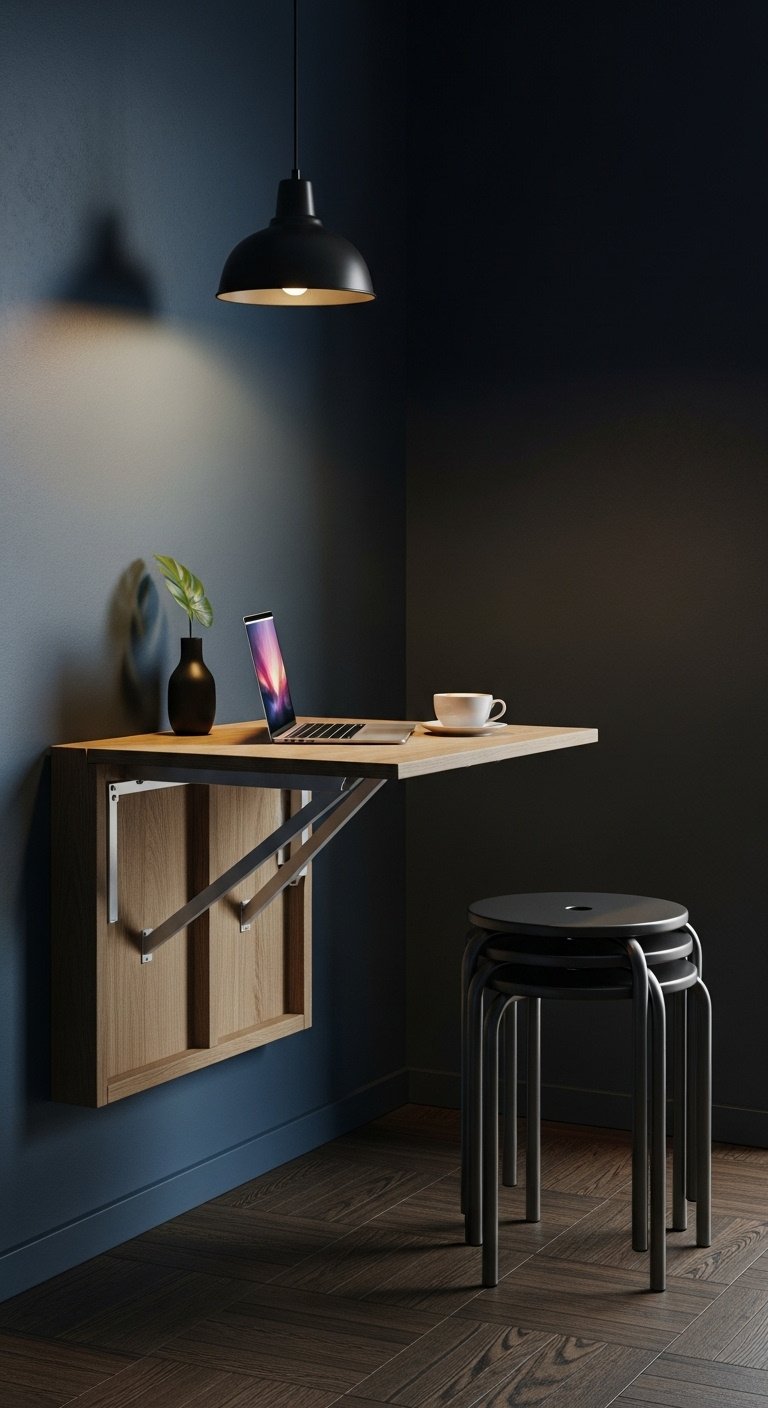
Save this space-saving furniture idea for your future cafe!
Materials Needed: Wall-mounted drop-leaf table, stackable stools or chairs, movable counter on caster wheels.
Step-by-Step Directions:
- Prioritize Flexibility: Choose furniture that serves more than one purpose. Benches can have hidden storage underneath.
- Install Foldable Elements: Mount drop-leaf tables along a wall. These can be folded down when not in use to create more standing room.
- Choose Stackable Seating: Opt for stylish stools or chairs that can be easily stacked and stored away to clear floor space for events or cleaning.
- Consider a Mobile Counter: A small counter or display case on locking caster wheels can be moved easily to reconfigure the layout on the fly.
Lesson Learned: Avoid bulky, heavy furniture. Lightweight and modular pieces are your best friends in a small space, allowing you to easily test different layouts to see what works best for customer flow.
3. The Glow Up: Creating Ambiance with Layered Lighting
Lighting is one of the most powerful tools in interior design, and for a small cafe, creating a warm and inviting ambiance requires layering different types of light sources. A single, harsh overhead light can make a space feel flat and clinical. By combining ambient, task, and accent lighting, you create depth, highlight key features, and give yourself the flexibility to change the mood from bright and bustling to cozy and intimate with the flick of a switch.
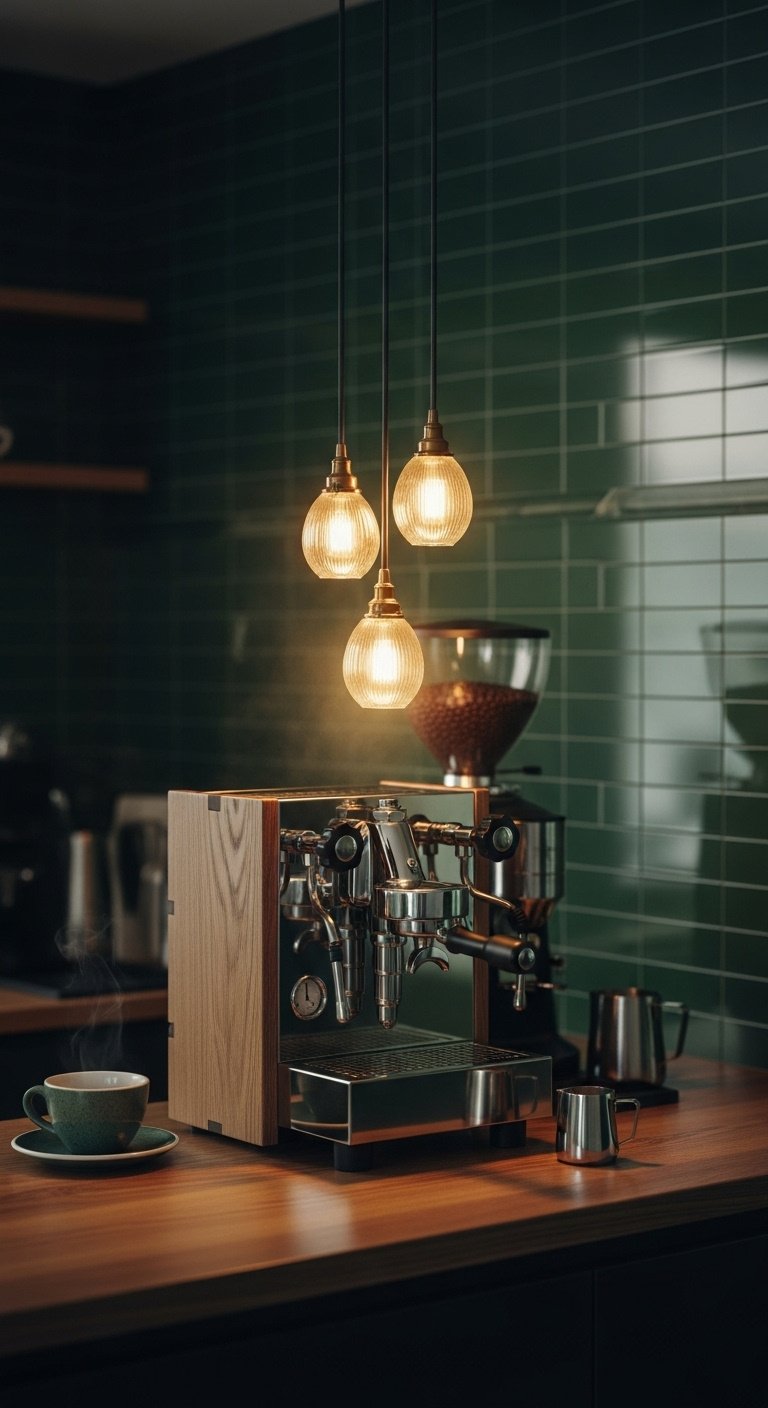
Love this cozy vibe? Pin it to your ‘Cafe Lighting’ inspiration board!
Materials Needed: Pendant lights (for task lighting), wall sconces or string lights (for ambient lighting), track lighting (for accent lighting), dimmer switches.
Step-by-Step Directions:
- Maximize Natural Light: Keep windows unobstructed. Use light, airy curtains if privacy is needed.
- Layer Your Lights: Don’t rely on one overhead source. Combine three types:
- Ambient: General, overall illumination (e.g., subtle track lighting, string lights).
- Task: Focused light for specific areas (e.g., pendant lights over the counter and tables).
- Accent: Light used to highlight features (e.g., a small spotlight on artwork or a menu board).
- Install Dimmers: Dimmers are essential for controlling the mood. Bright for the morning rush, and warmer and dimmer for a cozy evening vibe.
Pro-Tip: Use warm-toned bulbs (2700K-3000K) to create a welcoming, cozy atmosphere. Bright, cool lighting can feel sterile and encourages faster customer turnover, while warmer light invites guests to linger.
4. The Mirror & Tile Trick: Creating Illusions of Space
To instantly make a small cafe feel brighter and more expansive, strategically place a large mirror and use light-colored, glossy tiles to reflect light. This classic designer trick works wonders in compact areas. A mirror creates an illusion of depth by duplicating the space it reflects, while glossy surfaces bounce both natural and artificial light around the room, eliminating dark corners and enhancing the overall sense of openness.
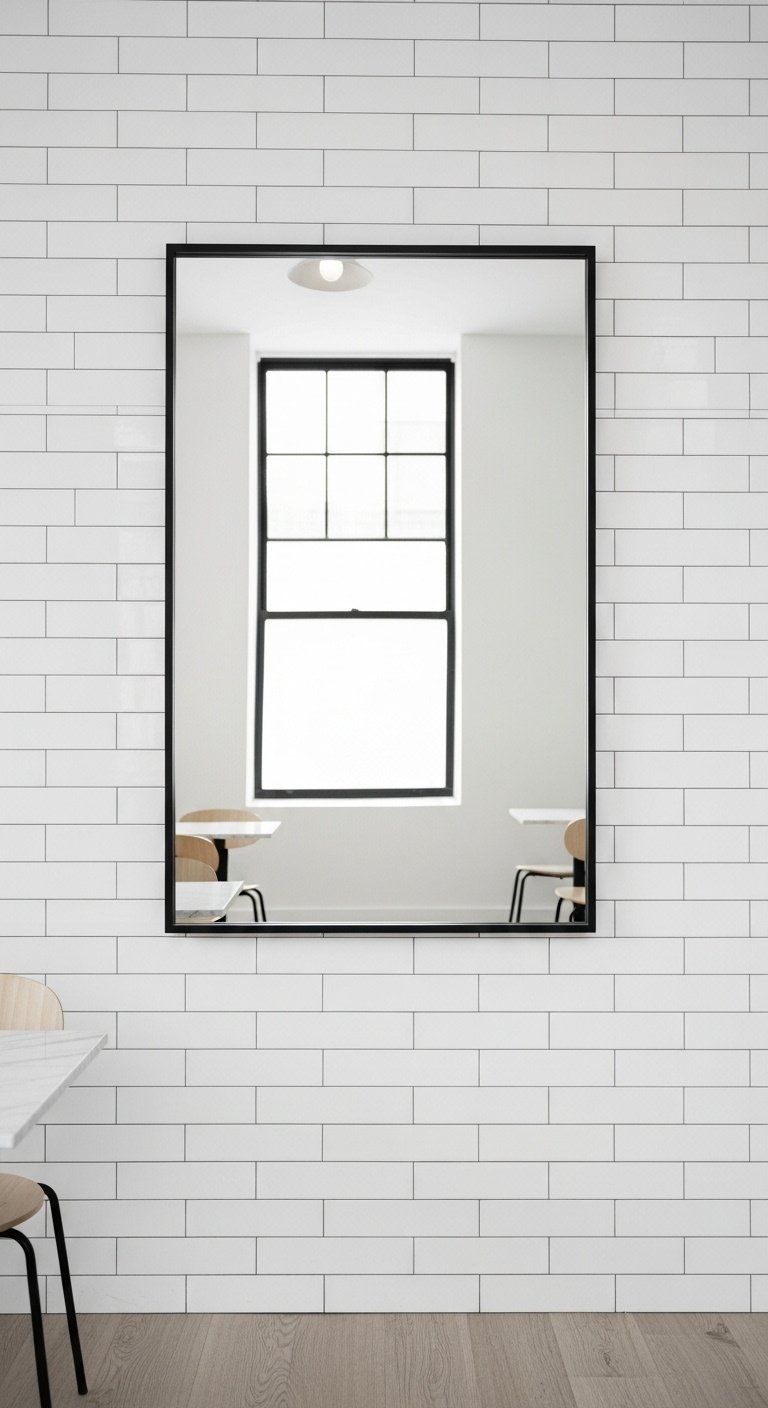
A genius trick for small spaces! Save this idea now.
Materials Needed: Large framed mirror, glossy wall tiles (e.g., subway or Zellige), tile adhesive, grout, level.
Step-by-Step Directions:
- Identify a Key Wall: Choose a long wall without windows to place a large mirror. This will create the most dramatic effect.
- Position for Reflection: Hang the mirror directly opposite a window or a primary light source to bounce light around the room.
- Choose Glossy Tiles: Select light-colored tiles with a glossy finish for the backsplash behind the counter or for an accent wall. Their reflective quality will enhance the sense of space.
- Install Tiles: Apply tiles using adhesive and ensure they are level. Once set, apply grout to seal the gaps. For a budget option, consider high-quality peel-and-stick tiles.
Pro-Tip: Don’t overdo it with mirrors. One large, well-placed mirror is more effective and elegant than many small ones, which can create a cluttered, funhouse effect.
5. The Power of Palette: Light, Bright & Cohesive Colors
The colors you choose have a profound impact on the perception of space, and using a light, cohesive color palette is the foundation for making a small cafe feel airy and open. Dark, heavy colors can make walls feel like they are closing in, while whites, creams, and soft pastels recede, creating a sense of spaciousness. A limited, cohesive palette also reduces visual clutter, resulting in a calm, serene environment where the focus can be on your coffee and products.
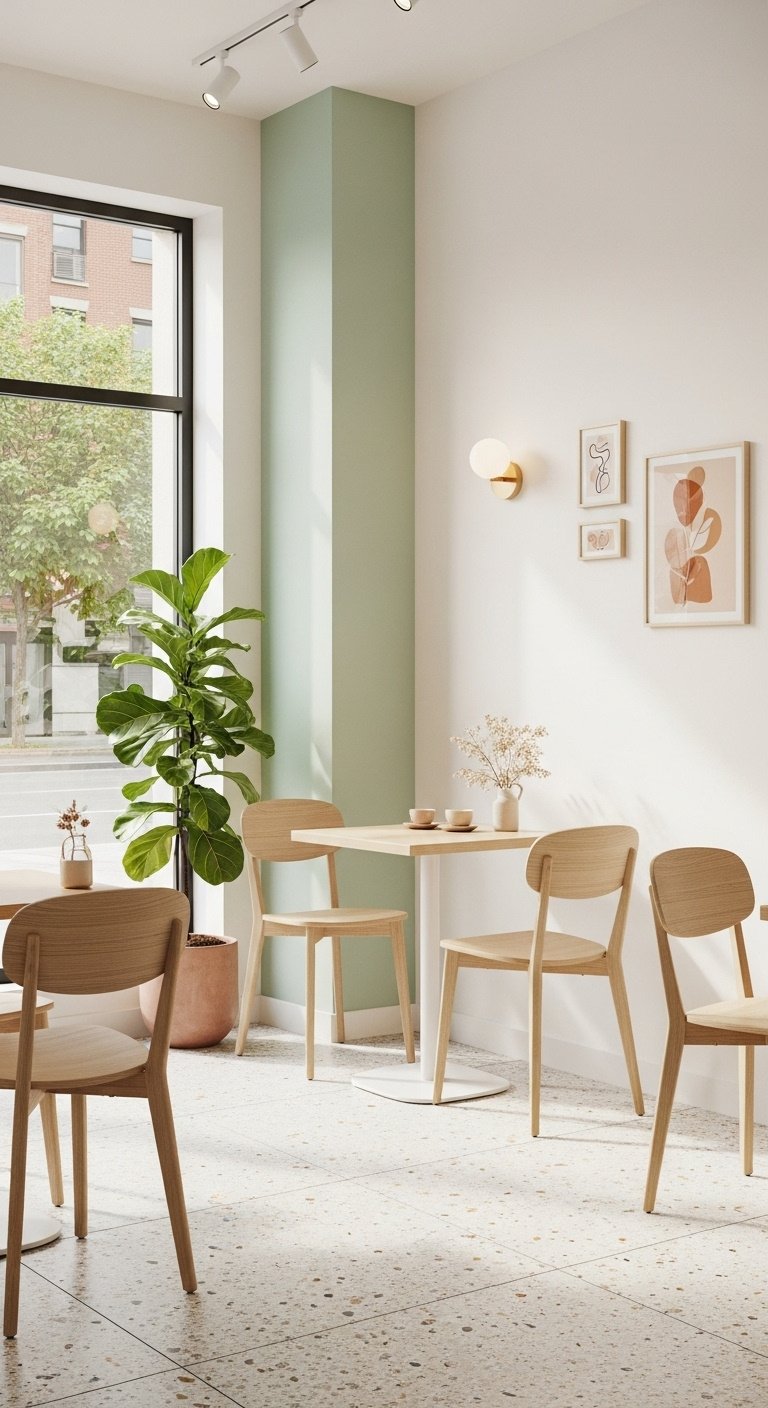
Pin this serene color scheme for your cafe inspiration!
Materials Needed: High-quality interior paint in your chosen colors (e.g., primary light color and a secondary accent color), painter’s tape, rollers, brushes, drop cloths.
Step-by-Step Directions:
- Choose a Light Base: Select a primary color for most walls from a light palette—whites, creams, light grays, or soft pastels. This creates an airy, open feeling.
- Select a Cohesive Palette: Stick to a limited palette of 2-3 colors to avoid visual clutter.
- Create a Focal Point: Paint one smaller wall (an accent wall) in a bolder or darker shade to add depth and personality without overwhelming the space.
- Paint the Ceiling: Paint the ceiling a brilliant white, or even a shade lighter than your walls, to make it feel higher.
Pro-Tip: Use a satin or eggshell paint finish. These have a slight sheen that reflects more light than a matte finish, subtly contributing to a brighter, more spacious feel.
6. Budget Biophilia: Bringing the Outdoors In
To add life, color, and a sense of calm to your cafe without spending a fortune, incorporate a variety of low-maintenance indoor plants into your decor. This concept, known as biophilic design, connects people with nature and can make any space feel fresher and more inviting. Plants are a budget-friendly way to fill empty corners, add texture, and purify the air. They are a simple addition that makes a huge impact on the overall atmosphere.
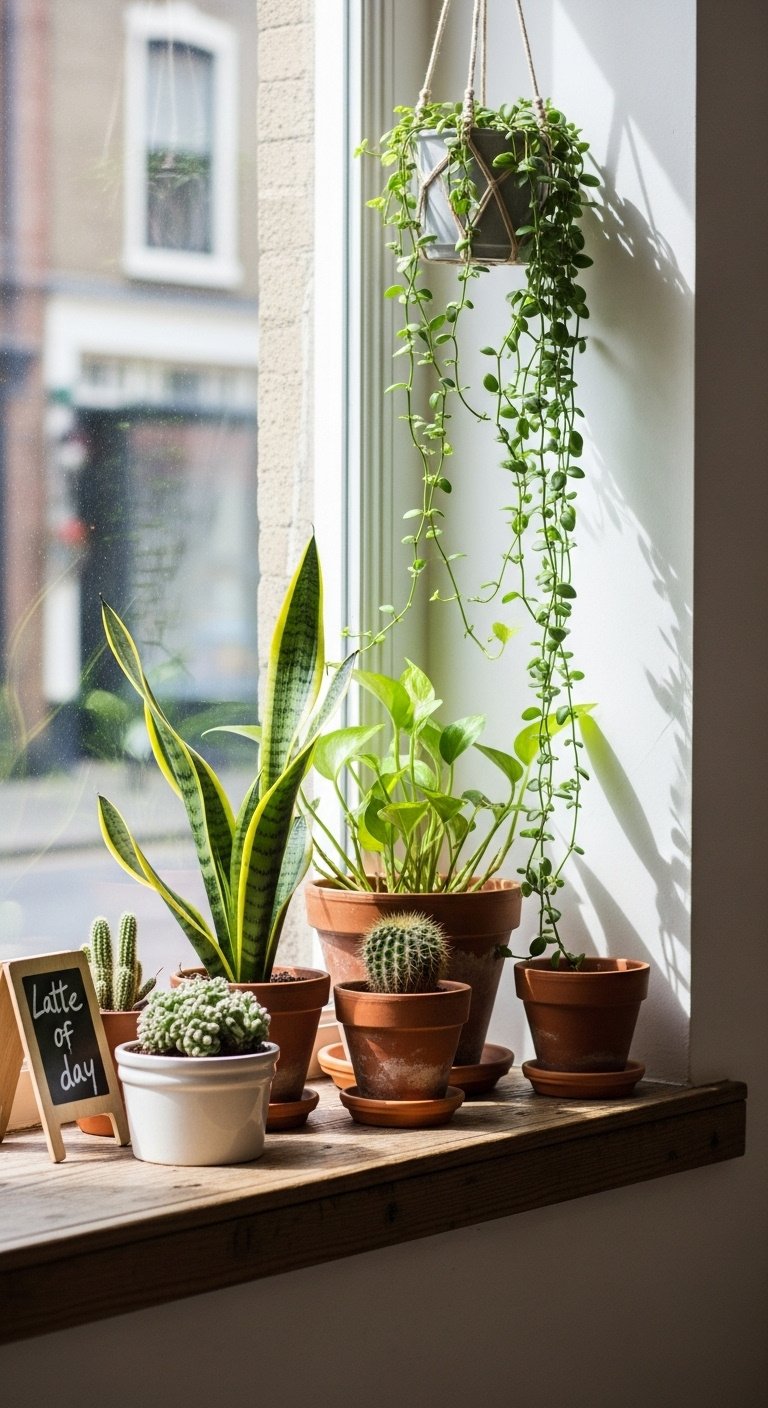
Add some green to your feed! Save this fresh decor idea.
Materials Needed: A variety of low-maintenance indoor plants (e.g., snake plants, pothos, ZZ plants), pots of various sizes, potting soil, small hanging planters.
Step-by-Step Directions:
- Assess Your Light: Choose plants that will thrive in the amount of natural light your cafe receives.
- Go Vertical: Use hanging planters or place small pots on high shelves to add greenery without taking up valuable table or floor space.
- Group Plants Together: Create small vignettes by grouping 3-5 plants of varying heights and textures on a windowsill or in a corner.
- Use Herb Pots: Consider small pots of fresh herbs like mint or basil near the counter. They look great, smell wonderful, and can even be used in drinks or dishes.
Lesson Learned: Don’t have a green thumb? High-quality artificial plants can provide the same visual impact with zero maintenance. Mix in one or two real, easy-care plants to make the fakes look more convincing.
7. The Interactive Nook: A Chalkboard or Pegboard Wall
Creating a dynamic focal point is easy and affordable by dedicating one wall to an interactive element like chalkboard paint or a pegboard system. This approach is both functional and decorative. A chalkboard wall can serve as your menu, a place for daily specials, or a canvas for local artists. A pegboard offers versatile, changeable storage and display for merchandise, mugs, or plants. Both options add personality and encourage customer engagement.
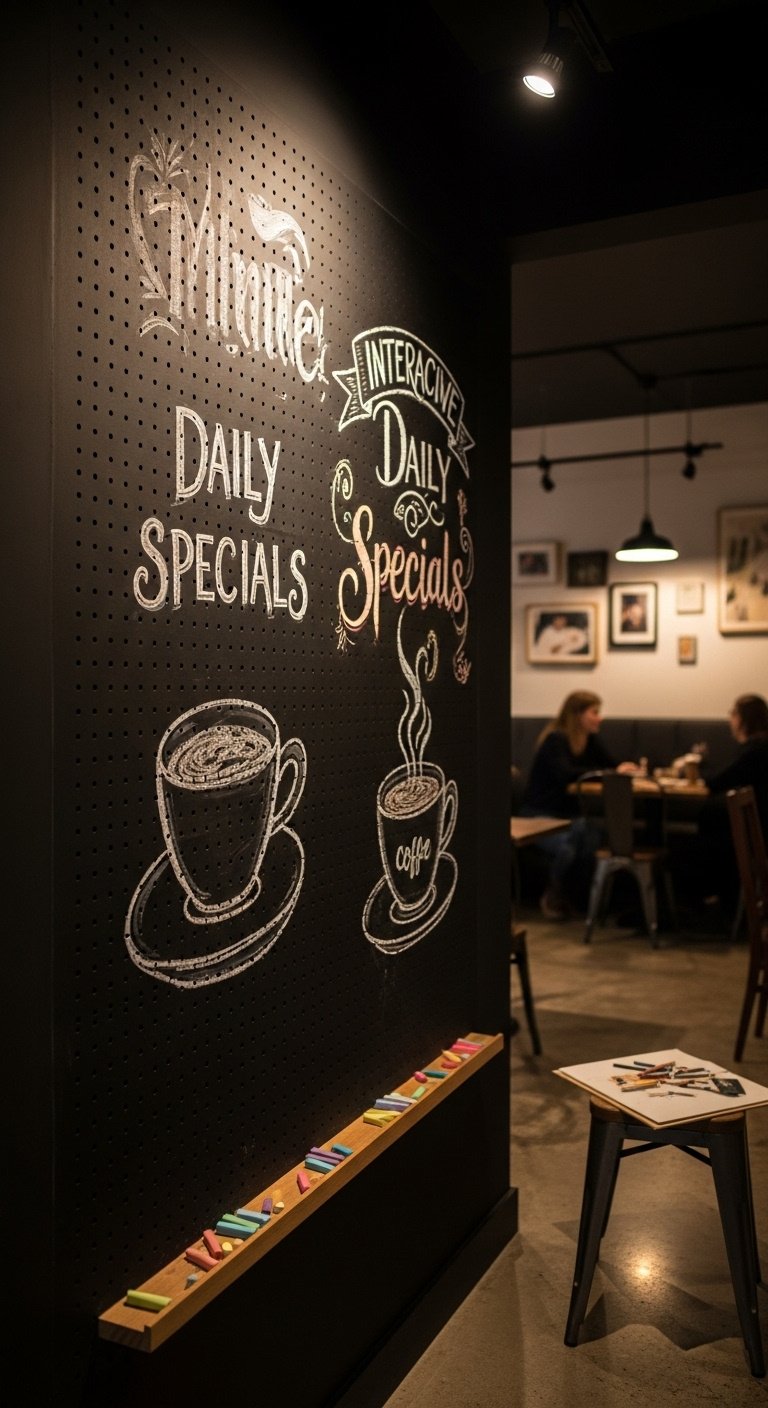
What a focal point! Pin this interactive wall idea.
Materials Needed: Chalkboard paint or a large pegboard panel, chalk or liquid chalk markers, small hooks and shelves for the pegboard, rollers/brushes.
Step-by-Step Directions:
- Choose Your Wall: Select a prominent wall that customers will see as they enter.
- Apply Chalkboard Paint: Prep the wall surface as directed on the paint can. Apply 2-3 coats of chalkboard paint for a durable finish. Let it cure completely (usually 3 days) before writing on it.
- Or, Install a Pegboard: Securely mount a large pegboard to the wall. This is excellent for hanging mugs, small plants, and retail items.
- Get Creative: Use the chalkboard for your menu, daily specials, or a “quote of the day.” Encourage customers to leave doodles or messages in a designated corner.
Pro-Tip: For a professional look on your chalkboard wall, hire a local artist for the initial design. You can then easily update the daily specials yourself. This supports another local creative and gives you a standout feature.
Key Takeaways: Your Quick Guide to mini cafe design interiors
- Maximize Vertical Space: Use tall, open shelving to draw the eye up and provide storage without cluttering the floor.
- Choose Flexible Furniture: Opt for stackable, foldable, and movable pieces to easily adapt your layout.
- Layer Your Lighting: Combine ambient, task, and accent lighting with dimmer switches to create a warm, inviting mood.
- Reflect Light: Use glossy, light-colored tiles and one large, strategically placed mirror to make the space feel bigger and brighter.
- Add Greenery: Incorporate low-maintenance plants to add life, color, and a fresh atmosphere on a budget.
People Also Ask About mini cafe design interiors
How can I design a small cafe on a low budget?
To design a small cafe on a low budget, focus on high-impact, low-cost elements. Use a thoughtful color palette, DIY decor like a chalkboard wall, and repurposed or upcycled furniture. Maximize natural light to save on electricity and invest in a few quality statement pieces, like unique pendant lights, to create a focal point.
How do you make a small cafe look bigger?
To make a small cafe look bigger, use a light and neutral color scheme and incorporate a large mirror opposite a window to reflect light and create an illusion of depth. Utilize vertical space with floor-to-ceiling shelving and choose furniture with a slim profile or raised legs to show more floor space.
What is the best layout for a small coffee shop?
The best layout for a small coffee shop prioritizes a clear customer flow from the entrance to the counter and then to the seating area. An open-plan design with bench or banquette seating against walls maximizes floor space. Using multi-functional furniture allows for flexibility in the layout.
Final Thoughts
Designing a mini cafe is a testament to the idea that creativity thrives within constraints. By using these genius strategies, your small space can become your greatest asset—a cozy, intimate, and unforgettable destination. Every choice, from a reflective tile to a hanging plant, contributes to a unique story. Which of these ideas are you most excited to try in your own space? Let us know in the comments below

